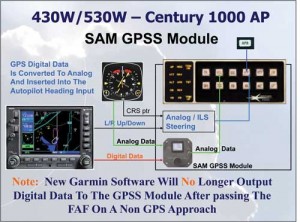by Michael Kaufman
It seems like I have become an autopilot troubleshooter since beginning my articles on autopilots in Midwest Flyer Magazine. After coming to me for some instruction following an autopilot repair, fellow pilot Galen Manternach of Wisconsin Rapids, Wis., and I found that it would be necessary to return to the shop. After briefing on how to program the autopilot, which in this case was a King KFC 225 with flight director and altitude preselect, we departed using the GA button to set pitch on the flight director for climb out. After reaching a safe altitude, the autopilot was turned on with the preselected altitude set to 3000 feet. The airplane did not level off as programmed, so the rest of the flight was focused on troubleshooting. After several phone calls, the aircraft was on its way back to the autopilot shop.
 So let’s apply some autopilot basics to help us better understand what happened before proceeding to my originally intended subject (GPSS) or “roll steering.”
So let’s apply some autopilot basics to help us better understand what happened before proceeding to my originally intended subject (GPSS) or “roll steering.”
Autopilots use servos to translate electrical energy into mechanical outputs to fly the airplane. As a safety feature, it is necessary for the pilot to be able to overpower these servos so a safety or slip clutch is included as part of the servo. In our case, a remanufactured servo had this clutch set too loose, thus slipping rather than applying elevator down pressure. It is very important to preflight the autopilot as part of the checklist prior to flight and follow the manufacturer’s approved procedures. In some cases, this includes the pilot overpowering the servo to check the slippage of this clutch. This should not be done on all autopilots, as it may damage the servos, so please check your manual! Two servos later, the autopilot in Galen’s airplane is now working well.
There are a lot of great features available on today’s autopilots, but the basics have not changed since the 1960s. What I consider as most important on any autopilot is the ability to keep the wings level and fly a heading and altitude. In my first article in this series on autopilots, I mentioned altitude hold as this is how one gets in trouble with ATC, as their separation is based primarily on altitude. Back before GPS when we flew VOR signals on the autopilot, there was a constant “S” turn on intercepting a signal. It would take several corrections on the autopilot to get established on course. Today, we have GPS and with it a great creation called GPSS or “roll steering.” Let’s cover the history and operational characteristics of GPSS and available units.
My first recollection of GPSS came with the King KLN 90 GPS and the King KFC 225 autopilot. In order for this to work, we need a GPS that can output a digital signal and an autopilot that could read the digital signal. The cool part of GPSS is its ability to precisely capture a course and fly it applying the necessary wind correction, no more hunting and “S” turns. The early GPS units with digital output only had GPS approaches in their databases, so we could only use this neat feature on GPS approaches. Garmin broke the data base barrier by including all published approaches, making GPSS the latest great advancement in aviation navigation with the introduction of the Garmin 430 and 530. Other digital autopilots came on the market, along with add-on units to convert the digital signal to analog to use with older autopilots. Some of the manufacturers of these digital-to-analog converters included DAK and Icarus, and are priced from $700.00 and up, plus installation. A very important item to remember when using these converters is that the autopilot must be set to “heading mode,” and turning the converter on or off selects whether you are flying GPSS or just the heading mode. There should be a light or indicator to tell the pilot the mode he is in when the autopilot function light indicates heading.
The first GPS manufacturer to take full advantage of all of the GPSS functions and features was the Apollo CNX 80 that later became the Garmin 480 and was later discontinued by Garmin. The CNX 80 was the first WAAS box, and it allowed a digital autopilot to fly course reversals, procedure turns, and holding patterns. To this day, the CNX 80 has some great features that have not yet been incorporated into the Garmin 1000 box. I will include more details on the CNX 80 in a future column dedicated to WAAS.
When I get into an aircraft to give instruction, especially instrument instruction, I now find that 80 percent of the aircraft are equipped with a WAAS GPS and some sort of GPSS autopilot or digital-to-analog converter. These aircraft as equipped can be programmed to fly to the initial approach fix, do a course reversal, and fly the approach and the missed approach procedure when necessary if properly set up, completely on the autopilot.
There are some secrets that I need to share on the proper set up. First, we must program and activate the approach selecting the initial approach fix we wish to use. REMEMBER, every approach must begin at an initial approach fix unless we are getting radar vectors. (I will address using radar vectors in a future column on GPS and WAAS.)
The next step after activating the approach is to turn on the autopilot and select GPSS. The airplane should proceed to the next selected waypoint in the flight plan. This may be part of a published transition or the initial approach fix, then do a course reversal or procedure turn if required and become established inbound on the intermediate or final approach course.
The next step is very important and often forgotten. Once established inbound, it is necessary to select the approach mode on the autopilot. This switches the autopilot back to analog mode and allows the autopilot to intercept and follow the glideslope. Note, a few next generation autopilots will fly a digital glideslope when provided on a WAAS approach, and there is no need to select the approach mode on the autopilot.
More than 75 percent of all published approaches today incorporate some sort of vertical guidance to landing. These include ILS, LPV, LNAV/VNAV and LNAV+V. All of the previously mentioned approaches when depicted with a glideslope will clear all stepdown fixes when following the glideslope. Approaches that do not include vertical guidance are LOC, VOR, NDB, LDA and SDF, but should still be flown using the approach mode on the autopilot once established inbound. Pilots should note that Garmin GPS units will discontinue the digital signal on all non-GPS approaches once passing the final approach fix. This was done to keep pilots from using the GPS signal on GPSS for non-GPS approaches.
We have covered some of the major components of autopilots, but there is still so much to say about them and little tricks one may use. I will be focusing the next several issues on flying with the GPS, but will continue to support autopilot usage as it applies.
Until then, always fly safe!
EDITOR’S NOTE: Michael “Mick” Kaufman is the manager for the Beechcraft Pilot Proficiency Program and a flight instructor operating out of Lone Rock (LNR) and Eagle River (EGV), Wisconsin. Kaufman was named “FAA’s Safety Team Representative of the Year for Wisconsin” in 2008. Email questions to captmick@me.com.












Pingback: Bau14c
Pingback: url
Pingback: งานสแตนเลส
Pingback: ประกันภัยโดรน
Pingback: ส่งsms
Pingback: Trustbet